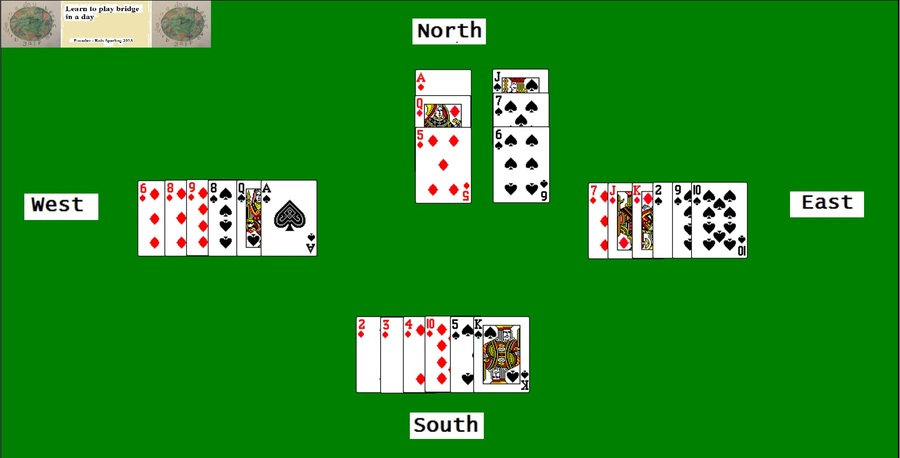Lesson 13 - Card play - 60 mins
Don't expect to play without mistakes after just a day of studying bridge. Most players make mistakes after twenty years of studying bridge. If you and your partner agree to discuss every hand and the way you each played it, in a non judgmental way, then you will enjoy bridge and improve very quickly.
If you want to improve at bridge try using the following process as soon as the final bid is made and the contract is won.
1 - Remember who bid what
If a player bid a suit, it is usually a good sign that they have at least 4 of that suit and at least 1 high card and 11 or more points. Remembering this during the play may help you make an extra trick now and again.
2 - Plot the hand
Before playing your first card, work out in your head how you want this hand to go. How many winners do you have? How many and how will you find any extra tricks needed to win or defeat the contract? Always remember to try and make your contract as quickly as possible. If you lead, whether in defence or attack, you have control. Lose the lead and you lose that control. Sometimes that is important.
3 - Count the cards
Counting the cards is very important and the better you get at it the more rewards you will reap. It really can make the biggest difference, especially for money. Many times in a session of bridge, knowing how many cards of each suit are left in play will win you tricks.
A good way to train the memory is to begin by counting how many cards of each suit are played and remembering how many are left. For instance if clubs are led first and everybody follows suit, you know that 4 clubs have been played and there can only be 9 clubs left. Try to remember this information, especially for important suits that you think might have a significant impact on the making or breaking of the contract.

The Lead
The opening lead is made by the player to the left of the declarer. In the next lesson, you will learn how to make a strong opening lead. The winner of the opening trick then leads. The winner of that trick then leads etc. until all the cards have been played.
If you have the lead, you have the option of playing any card in your hand you choose. If dummy has the lead, the declarer will choose the card to play from dummy. After the lead, you must follow suit if you are able to.
Card Play guidelines
If you follow the basic guidelines below strictly to begin with, you and your partner will soon start to understand when you can be less strict.
- If declarer, try to remove your opponent's trumps as soon as possible
If you have already worked out a plan for playing the hand it can be very annoying to have one of your winners trumped by an opponent. If you have enough trumps between you and your partner, usually seven or more, then removing your opponent's trumps is nearly always a good starting plan.
- Lead through strength
- Lead into weakness

Look at the hand above.
North is the dummy. You are West (the hand on the left) and it is your lead. You see that the dummy has strength in diamonds and weakness in spades. You should lead a small diamond through dummy's strength. If your partner wins the trick then they should lead a spade back into dummy's weakness.
Try out this hand yourself. Deal out the cards and play them differently and see what the difference is.
- Always discard your lowest card if you can't win a trick
In the hand above, if you were to lead the ace of spades, your partner should discard their lowest card which is the 2 of spades
Playing in defence:
- Return your partner's lead unless you have good reason not to
- Don't lead trumps unless you have good reason to
- Don't trump your partner's winner, you may regret it
- Lead the higher ranked card of a doubleton (2 cards in a suit)
- If you are the second player, usually play low
- If you are the third player, usually play high

Look at the hand above.
Your partner West leads 2 spades and north plays 3 spades. As thrid player, you are expected to play high. This will help you win tricks but also to draw out higher cards from your opponents.
When you play the king which is taken by the ace from south, your partner now has the highest spade which is the queen.
card play examples

Home
Copyright © August 2013 Rols Sperling
All rights reserved. Please e-mail Rols if you want to use any of the materials on this site.
|